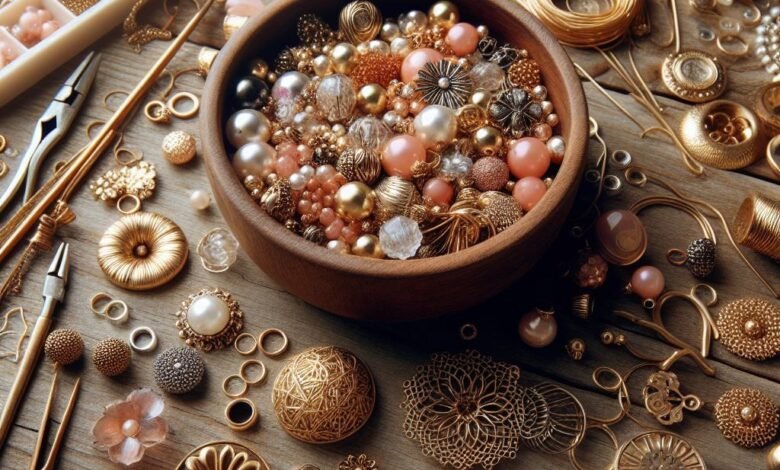
If you love the sparkle of gold but want something more durable and affordable than solid gold jewelry, you’ve probably come across terms like “gold-filled” and “gold-plated.” But what do they mean? How do the different types of gold jewelry compare, and which one offers the best mix of beauty, longevity, and value? Let’s dive into the shimmering world of gold jewelry and discover what sets gold-filled apart from the rest.
Solid Gold: The Timeless Standard
Let’s start with the basics. Solid gold is the purest form of gold jewelry you can find. It’s made entirely of gold, with varying degrees of purity measured in karats. The higher the karat number, the more pure gold the piece contains.
Typical purities you’ll find are:
10K Gold: 41.7% gold, the most affordable solid gold option.
14K Gold: 58.3% gold, a popular choice in balancing durability and cost.
18K Gold: 75% gold, offering a richer yellow hue and a higher price point.
Solid gold jewelry is the classic choice. It’s resistant to tarnishing, hypoallergenic, and an authentic heirloom piece. The downside? It’s the most expensive option due to its high gold content.
Gold-Plated: A Flash of Gold
Gold-plated jewelry offers a budget-friendly way to achieve the look of gold. It starts with a base metal, like brass or copper, and receives a fragile coating of gold through electroplating. The thickness of this gold layer is minimal and, thus, more prone to wear and tear over time. Here’s why:
Susceptibility to wear: The thin gold layer can wear off, exposing the base metal and affecting the appearance of the jewelry.
Potential for allergies: The base metal may contain allergens like nickel, causing skin reactions in some people.
Shorter lifespan: Gold-plated jewelry won’t last as long as its solid gold or gold-filled counterparts.
While a tempting option for its affordability, gold-plated jewelry isn’t built to last, making it a less ideal choice for pieces you want to wear frequently.
Gold-Filled: The Best of Both Worlds
Gold-filled beads and findings strikes a fantastic balance between the luxury of solid gold and the affordability of gold plating. A thick layer of solid gold, generally 12K or 14K, is bonded to a base metal core, usually brass or copper, to create gold-filled jewelry. The combination of heat and pressure in this bonding process produces a fusion that is both strong and long-lasting.
Significant gold content: By law, gold-filled jewelry must have a gold layer at least 5% of the item’s total weight. This translates to a much thicker layer of gold compared to gold plating.
Durability: Gold-filled is highly resistant to tarnishing and wear and tear, making it an excellent option for everyday jewelry.
Hypoallergenic: The substantial gold layer protects your skin from coming into contact with any potential allergens in the base metal.
Affordability: While more expensive than gold-plated jewelry, gold-filled is significantly more affordable than solid gold.
How to Tell the Difference
Now that you understand the distinctions, how do you tell these types of gold apart? Here are a few tips:
Look for markings: Gold-filled jewelry will often be stamped with “GF” or a fraction like “1/20 14K GF” (indicating 1/20th of the weight is 14K gold). Solid gold jewelry will be stamped with its purity (10K, 14K, 18K). Gold-plated jewelry might not have any markings or may be stamped “GP” or “HGE” (Heavy Gold Electroplate).
Consider the price: If the price seems too good to be true for the size of the piece, it likely isn’t solid gold.
Observe wear over time: Gold-filled jewelry will hold its shine far longer than gold-plated due to the thicker gold layer.
Also, Read: Buying Gold-Filled Beads Wholesale for the First Time
Choosing the Right Gold for You
So, which type of gold jewelry is right for you? Ultimately, it comes down to your personal preferences and needs. Here’s a breakdown of factors to consider:
Budget: If you’re on a budget, gold-plated is the cheapest option. Gold-filled is a worthy mid-range investment, while solid gold is the most expensive but beautiful heirloom investment.
Durability: Solid gold or gold-filled are the clear winners for everyday jewelry pieces you want to last. Gold-plated will wear faster, especially with frequent use.
Skin Sensitivities: Gold-filled and solid gold are generally hypoallergenic, while gold-plated jewelry may cause reactions due to the base metal.
Long-Term Value: Solid gold holds its monetary value best. Gold-filled offers excellent quality and longevity for its price. Gold-plated has less long-term value due to its wearability.
What’s the Difference Between High-Quality Gold-Filled Beads and Low-Quality Gold-Filled Beads
Not all gold-filled beads are created equal. While bonding a thick layer of gold to a base metal core may seem straightforward, there’s a surprising amount of variation in the quality of gold-filled beads on the market. Understanding these differences will help you choose the best materials for your jewelry designs, ensuring they’re beautiful and built to last.
Factors Affecting Gold-Filled Bead Quality
Here’s a breakdown of the critical factors that distinguish high-quality from low-quality gold-filled beads:
Karat of Gold: Gold-filled beads can be made with varying karats of gold, most commonly 12K or 14K. Higher karat gold translates to a richer yellow color and increased resistance to tarnishing.
Thickness of Gold Layer: Legally, gold-filled items must have at least 5% of their total weight in gold. However, higher-quality beads will go beyond this minimum. Look for beads labeled “heavy gold-filled” or those that specify a fraction like “1/10 14K GF” (meaning 10% of the total weight is 14K gold). A thicker gold layer adds both durability and longevity to the bead.
Manufacturing Process: The best quality gold-filled beads are made through pressure-bonding, creating a seamless, long-lasting fusion between the gold and the base metal. Lower-quality beads may use cheaper plating processes, resulting in a less durable gold coating that is more prone to flaking or wear.
Base Metal: The base metal used beneath the gold layer impacts the overall quality and longevity of the bead. Typically, brass or copper are used, but some higher-quality beads may feature a premium base like sterling silver. A quality base metal reduces the risk of discoloration showing through if the gold layer gets a subtle scratch.
Finishing: High-quality beads receive extra care in the finishing process. They may be polished to a smooth, bright finish or given a protective coating to enhance durability further.
How to Spot High-Quality Gold-Filled Beads
While it’s not always possible to assess every quality factor by eye, here are some things to look out for:
Seller Reputation: Purchase your beads from reputable jewelry supply stores known for their quality and transparency about their materials.
Markings: Look for beads marked with the karat of the gold used and the fraction indicating its percentage of the total weight, such as “1/10 14K GF.”
Price: Expect to pay a little more for high-quality beads. Significantly cheaper beads often indicate a thinner gold layer or less rigorous manufacturing.
Appearance: High-quality beads should have a smooth, bright finish with a consistent gold color. Avoid beads with noticeable scratches or uneven coloring.
The Importance of Investing in Quality
While tempted by cheaper gold-filled beads, here’s why investing in high-quality materials is the more intelligent choice:
Durability: High-quality gold-filled beads are remarkably resistant to wear, tarnishing, and discoloration, ensuring your jewelry pieces will look their best for years to come.
Skin Sensitivities: A thicker gold layer and a quality base metal reduce the risk of skin reactions or allergies significantly.
Value: While initially costing more, high-quality beads will provide better long-term value and customer satisfaction. Cheap beads that tarnish or fade quickly will be a wasted expense.
Caring for Your Gold-Filled Beads
Proper care will extend their lifespan and beauty even with high-quality gold-filled beads. Remember to:
Clean Gently: Use warm, soapy water and a soft cloth for occasional cleaning.
Store Safely: Store beads in a pouch or a lined jewelry box to prevent scratches.
Protect from Harsh Elements: Avoid exposing your gold-filled bead jewelry to harsh chemicals, chlorine, and excessive sweat as much as possible.
By choosing wisely and caring for your gold-filled beads, you can create stunning, lasting jewelry pieces that bring a touch of affordable luxury to your collection.
Also, Read: Winning Designs and Projects Using Sterling Silver Sports Charms
Caring for Your Gold Jewelry
No matter which type of gold jewelry you choose, proper care will help it look its best for years. Here are some essential tips:
Please keep it clean: Use warm, soapy water and a soft cloth to remove dirt and oils. Rinse and dry thoroughly.
Avoid harsh chemicals: Chemicals in lotions, perfumes, cleaning products, and pools can damage gold jewelry over time.
Store it carefully: Store your jewelry in a soft pouch or lined jewelry box to prevent scratches and tangles.
Remove before activities: It’s wise to remove your jewelry before exercise, swimming, gardening, or any activity that causes sweating or exposure to chemicals.
Gold-Filled: A Versatile and Accessible Choice
Gold-filled offers an exceptional compromise for those seeking a beautiful, long-lasting addition to their jewelry collection without the premium cost of solid gold. Its substantial gold content provides the allure of gold and the ability to withstand the test of time.
With proper care, your gold-filled jewelry pieces will shine for years, proving a worthy investment for the discerning jewelry lover. So, the next time you browse that jewelry display, you’ll be armed with the knowledge to make informed choices understanding the value and craftsmanship inherent in each dazzling piece.
Gold-Filled Jewelry: A Great Start for Beginner Crafters
Gold-filled jewelry’s combination of quality materials, affordability, and workability makes it a fantastic starting point for budding jewelry designers. You can embark on your gold-filled jewelry-making journey at home with a small workspace, a few essential tools, and some creative spark.
Setting Up Your Home Workshop
You don’t need a fancy professional studio to start creating beautiful gold-filled pieces. Here’s what you’ll want for your basic setup:
Workspace: A well-lit, uncluttered table or desk where you can comfortably work. A protective mat is helpful to prevent tool marks.
Lighting: Good lighting is essential. A bright desk or daylight magnifying lamp will help you see details.
Storage: Small containers, bead trays, or organizers to keep your beads, findings, and tools neatly separated.
Ventilation: If you plan to do soldering, ensure your workspace has proper ventilation.
Essential Tools for Getting Started
Here are the essential tools to begin working with gold-filled materials. These critical items will form the foundation of your jewelry-making toolkit:
Pliers: The backbone of jewelry making! Here’s why you’ll need a few different types:
Round nose pliers: Their tapered, rounded jaws are perfect for creating loops, bends, and curves in wire. They’re indispensable for forming jump rings and eye pins.
Chain nose pliers: Ideal for delicate work and tasks that require precision. Their flat, tapered jaws help you grip wires, open and close jump rings, and make more minor bends.
Flat nose pliers: These feature flat, wide jaws for gripping, flattening, and making sharp, angular bends. They’re also handy for holding and manipulating small findings.
Wire cutters: Choose cutters specifically designed for jewelry making to ensure a clean, precise cut on your gold-filled wire:
Flush cutters: These provide a very flush cut, perfect for getting close to connections or beads without leaving a sharp wire end.
Side cutters: A versatile, valuable option for general cutting or thicker gauge wire.
Jump ring tool (optional): While not strictly essential, a jump ring tool makes opening and closing jump rings (those tiny connecting rings) much easier and more precise, especially for beginners.
Ruler or Measuring tape: Essential for accurately measuring lengths of wire, chain, or other elements for your jewelry designs.
Bead board (optional): A bead board is a great organizational tool. It features grooves and measurement markings to help lay out and size your beaded designs before stringing.
Additional Tools for Expanding Techniques:
As you progress in your jewelry-making journey, you might consider adding these to your arsenal:
Nylon-jaw pliers: These feature nylon tips to prevent marring the surface of your gold-filled pieces when working with delicate wires or finished creations.
Mandrels (Cylindrical Rods) Come in various sizes for forming rings and creating specific curves or shapes.
Metal files and sandpaper: Used for smoothing rough edges, refining shapes, and polishing finished pieces.
Bench block: A flat, solid surface that supports your work when using a hammer or other tools that require a stable work surface.
Tips for Choosing Tools:
Quality matters: Invest in good-quality tools that feel comfortable in your hand. These will last longer and make your crafting experience much more enjoyable.
Starter Kits: Many jewelry supply stores offer beginner’s toolkits that include an essential selection of pliers and cutters.
Build your collection gradually: You can always add specialized tools as your skills and project ideas expand.
Where to Find Gold-Filled Materials
Reputable online jewelry supply stores offer a wide selection of gold-filled findings, chains, wire, and beads. Look for suppliers that specify the karat of gold used and the thickness of their gold-filled materials.
Beginner-Friendly Projects
Gold-filled is wonderfully forgiving for beginners! Here are some simple projects to start with, along with ways to add your creative flair:
Beaded bracelets and necklaces: Learn basic stringing techniques with gold-filled beads and chains while exploring design options.
Bead variety: Experiment with different shapes, sizes, and colors of gold-filled beads. Add gemstone beads, crystal accents, or textured metal beads for contrast.
Chains & Closures: Choose from various delicate gold-filled chains. Practice adding clasps and jump rings for secure closures.
Personal Touches: Include meaningful charms, birthstone beads, or stamped initials for a personalized touch.
Wrapped loop pendants: A simple yet elegant technique – wrap gold-filled wire around gemstones or beads to create beautiful pendants.
Stone Selection: Explore semi-precious gemstones, unique beach glass finds, polished cabochons, or vintage buttons.
Wire Wrapping: Practice basic loops and swirls with gold-filled wire, adding a touch of intricate detail.
Multiple Elements: Combine wrapped pendants with beaded dangles or chain tassels for a more complex design.
Chain earrings: Attach charms or beads to delicate gold-filled chains for effortlessly chic earrings.
Charming Designs: Choose from various gold-filled charms – feathers, initials, symbols, or dainty gemstones.
Earring Hooks: Practice attaching your creations to gold-filled earring hooks, exploring styles like French hooks or lever backs.
Bead Dangles: Add single beads clusters or create tiny wire-wrapped bead dangles for an extra element.
Wire-wrapped rings: Master wire wrapping basics and create unique, personalized rings.
Start Simple: Begin with plain gold-filled wire and learn basic wrapping and coiling techniques.
Focal Points: Incorporate beads, gemstones, or small cabochons as the centerpiece of your ring.
Textured Bands: Add interest to your ring band by hammering the wire gently for texture or twisting multiple wires together.
Remember: Don’t be afraid to experiment! The beauty of DIY jewelry lies in the ability to create something utterly unique to your style.
Resources and Inspiration
Online tutorials and blogs: Find many free tutorials on platforms like YouTube or dedicated jewelry-making blogs.
Jewelry-making books: Check out your local library or bookstore for beginner-friendly guides to techniques and projects.
Social media: Communities on Instagram, Pinterest, etc., offer endless inspiration and support from fellow crafters.
Enjoy the Creative Journey
Gold-filled jewelry making offers a fantastic opportunity to express creativity while learning valuable skills. Start with simple projects, be patient with yourself, and remember, the joy is in the process just as much as the finished piece. Embrace the journey of crafting beautiful, lasting jewelry with the warmth and glow of gold!



